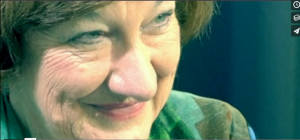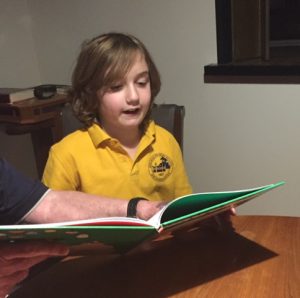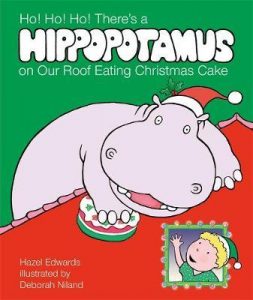The Book Belongs to the Reader, Not the Writer

Photo by Rob Kelly
When asked about how I feel about ‘my’ book, I explain that a book belongs to the imagination of the reader.
Readers relate to the character and sometimes they are unaware of the author or illustrator.
I’m ok with that. The author’s job is to craft the concept as well as possible. Then the reader has to crack the code of the words according to their experiences. Thus they ‘own’ it.
My picture book ‘There’s a Hippopotamus on Our Roof Eating Cake’ is almost 40 years old, (written in 1978 and published in 1980) and constantly in print. Generations of readers consider it ‘their’ book. Often the grandparent has introduced the book to their child, who did the same for the next generation.
‘Ho! Ho! Ho! There’s a Hippopotamus on our Roof Eating Christmas Cake’ is the seventh and last in the series about the imaginary, big friend with all the answers.
Son Trevelyan, when he was four, thought there was a hippopotamus on our roof eating cake. Last year, his nephew, my second grandson Henry was concerned about the same roof. Not the wildlife this time, but the fantasy of Santa and the problem of our skylight access.
Henry inspired ‘Ho Ho Ho’ when he offered me a chimney for Santa as we only had a skylight. Henry moved with his family into an older house in suburban Oakleigh, which had two chimneys. He was concerned Grandma’s house only had a skylight. How would Santa get in on Christmas Eve? So Henry offered to loan a chimney with GPS to redirect.
That became the ‘Skylight Santa’ photographic gift story which was much adapted to become ‘Ho Ho Ho…’ with the Christmas theme.
Henry taught me how to use Facetime and I helped him improve his reading fluency with our regular dates online.
There’s an acknowledgement to Henry Garnet Sheffield inside the picture book ‘Ho! Ho! Ho! There’s a Hippopotamus on Our Roof Eating Christmas Cake’.
That’s real. So it’s ‘his’ book, not mine.
How do you read together?
 I’m a digitally challenged, vintage grandma. I try to learn one new digital skill per day. Henry taught me how to use Face-time. In exchange, I helped him read more fluently. He was 7 when we started, and although interruptions occurred, we read every second night for about 9 months.. Either we had two copies of the same picture book, or he had to angle the book so I could see or at least guess the words.
I’m a digitally challenged, vintage grandma. I try to learn one new digital skill per day. Henry taught me how to use Face-time. In exchange, I helped him read more fluently. He was 7 when we started, and although interruptions occurred, we read every second night for about 9 months.. Either we had two copies of the same picture book, or he had to angle the book so I could see or at least guess the words.
The choice of books was his. He liked ‘how to make’ or factual books. But one night he jokingly brought out ‘There’s a hippo…’and his mother Kim said, ‘At least we’ve got a copy each of that and I know which word comes next.’
Readers ‘own’ factual books in a different way from fiction. A factual incident may inspire a work of fiction. But a reader indicates ‘ownership’ of a ‘how-to…’ book, by making the object or doing the experience, where it’s food, travel or new ways of problem solving. Unless it’s a series, they may not even remember the name of the author.
Why do you make books as family gifts?
Each birthday or Christmas, I compose a book as a story gift of the imagination for that grandchild, based on photos from the current year .My favourite was the history book of ideas, but others like the ‘ Who is Hiding?’ (which is now on Youtube)
Across the years, I’ve been invited to my grandkids’ schools.
Occasionally I get undue credit as a writer.
‘No, your grandmother DIDN’T write this book Henry,’ said the preschool teacher with a smile as she conducted storytime.
When I visited the 4 year old childcare room, Henry said, ‘Don’t all Grandmas write books?’
 One of the most creatively satisfying moments for me was sitting in the audience of the Garry Ginnivan Hippo Hippo Musical with Henry alongside. Suddenly I realized he was watching a performance of a story created from his Uncle and mother when they were younger than him.
One of the most creatively satisfying moments for me was sitting in the audience of the Garry Ginnivan Hippo Hippo Musical with Henry alongside. Suddenly I realized he was watching a performance of a story created from his Uncle and mother when they were younger than him.
For his 8th birthday, Henry wanted a history party. Kim, his mother, created an Egyptian party and the guests dressed up. I wrote a History ‘Book of Ideas’ as his gift, with spaces to add his own ideas later. Stories are to be shared and many are based on fragments of ideas which if not captured in the moment, get lost.
‘I’ve always written a story for each grandchild, each birthday or Christmas. It’s a kind of gift of the imagination. I’m hopeless at formatting, so the early ones were a bit rough in terms of layout. But each was about something of significance to the child that year. I worked from the photos. And to be diplomatic, I tried to include all family members.
Family History?
My own Grandma taught me to read before I went to school. She passed away when I was about the age Henry is now, and I remember her well.
And in my ‘Writing Non Boring Family History’ workshops, as an extra, I encourage writing a picture book for a specific child in your family.
Even adult readers ‘own’ the book if the experience explored is relevant to them. That’s why genuine stories, often based on real inspirations, are the ones which last.
And the author should be content to be a channel of ideas.
Ultimately the book belongs to the reader, not the creator of the book.
**********************************************
—
Hazel Edwards OAM is the Australian author of over 200 books for adults, children and adolescents.’Celebrant Sleuth;I do or die’ is her latest adult mystery. ‘Not Just a Piece of Cake; Being an Author’ is her quirky autobiography based on ‘anecdultery’ her term for crafting via story. Her books have been translated into ten languages, including Tamil, Korean, Chinese, Russian and Braille.
www.hazeledwards.com has details.
Category: Contemporary Women Writers, How To and Tips

























